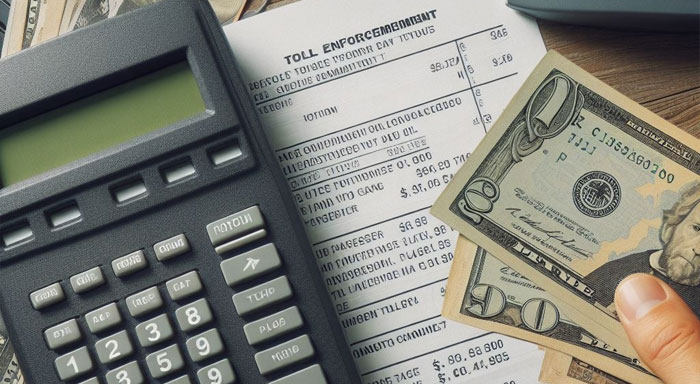Unlocking the Secrets of Toll Enforcement Invoices: A Comprehensive Overview
Welcome to our comprehensive guide on toll enforcement invoices! Whether you’ve received one in the mail or want to learn more about how it works, you’ve come to the right place. On this page, you’ll find everything you need to know about this, including:
- What is a Toll Enforcement Invoice: Learn what these are and why they’re important.
- How Do I Know If I Have One: Discover common scenarios for receiving a toll enforcement invoice and how to recognize one.
- Understanding the Invoice Breakdown: Get a detailed breakdown of the different components of a toll enforcement invoice, along with a sample invoice for reference.
- Payment Options and Deadlines: Explore various payment methods available and understand the importance of timely payment.
- Frequently Asked Questions (FAQs): Find answers to common questions about disputing invoices, avoiding future violations, and more.
Whether you’re looking to resolve a toll enforcement issue or simply want to stay informed, our guide has you covered. Dive in and empower yourself with the knowledge you need to navigate toll enforcement invoices with confidence!
What is a Toll Enforcement Invoice?
Imagine you’re driving on a highway and you pass through a toll booth. Sometimes, people forget to pay the toll, or their payment doesn’t go through. When this happens, a toll enforcement invoice might come your way. A toll enforcement invoice is like a bill that’s sent to you when you haven’t paid your toll. It’s a way for the toll authorities to remind you about the unpaid tolls that their electronic systems have captured.
Purpose:
Now, you might be wondering why these invoices exist. Well, their main job is to make sure tolls get paid. When you use a road or a bridge that requires a toll, you’re supposed to pay for it. But if you don’t, the toll enforcement invoice steps in to remind you. It’s not just about the toll money, though. The invoice also includes administrative fees and penalties. These help cover the costs of sending out the invoice and encourage people to pay their tolls on time.
How Do I Know If I Have a Toll Enforcement Invoice?
If you’re unsure whether you’ve received a toll enforcement invoice or not, this section will guide you through common scenarios that might lead to receiving one and how to recognize it when it arrives.
Understanding Common Scenarios:
- No Transponder: Transponders are devices in your vehicle that automatically pay tolls. If you don’t have one, or if it’s not working, the toll booth won’t register your payment. That’s when you might receive a toll enforcement invoice.
- Low Transponder Balance: Even if you have a transponder, it needs to have enough money loaded onto it to cover the toll. If it doesn’t, the toll won’t be paid, and you could end up with an invoice.
- Unregistered Vehicle: Toll agencies often link toll payments to vehicle registrations. If your vehicle isn’t registered with the toll authority or if the registration information is outdated, they won’t be able to match your toll to your account. In this case, they’ll send you an invoice instead.
Recognizing a Toll Enforcement Invoice:
- Look for the Agency Logo: Toll enforcement invoices typically display the logo of the agency that issued them prominently. This logo is often located at the top of the invoice.
- Check the Invoice Details: The invoice will contain specific information about the toll violation, including the date, time, and location of the violation. It will also detail how much you owe, including any additional fees or penalties.
- Review Contact Information: In case you have questions or need to resolve the issue, toll enforcement invoices usually provide contact information for the issuing agency. This information may include a phone number, email address, or website where you can find further assistance.
Understanding the Invoice Breakdown
Confused by the jargon on your toll enforcement invoice? This section explains each part in simple terms, from the unpaid tolls to the total amount due, so you can understand exactly what you’re being charged for.
Invoice Components:
- Unpaid Tolls: This section lists the tolls that haven’t been paid. It includes details like the date, time, and location of each unpaid toll.
- Violation Details: Here, you’ll find information about the specific violations that led to the unpaid tolls. This may include the reason for the violation and any relevant codes or descriptions.
- Administrative Fees: Toll enforcement agencies often add administrative fees to cover the costs of processing the invoice and managing the toll violation. These fees are typically included in the total amount due.
- Late Fees: If the invoice isn’t paid by the due date, late fees may be added. These fees encourage prompt payment and help cover the additional costs associated with late payments.
- Total Amount Due: This is the sum of all unpaid tolls, administrative fees, and late fees. It represents the total amount you owe to settle the toll enforcement invoice.
Payment Options and Deadlines

Available Payment Methods:
- Online: Paying online is often the quickest and most convenient option. Visit the toll authority’s website and follow the instructions to make a payment using a credit/debit card or electronic funds transfer.
- Mail: If you prefer traditional methods, you can mail a check or money order along with the payment stub from your invoice. Be sure to allow enough time for your payment to reach the toll authority before the deadline.
- Phone: Some toll authorities offer a phone payment option. Simply call the provided phone number and follow the automated prompts to make a payment using your credit/debit card.
- In-Person: For those who prefer face-to-face interactions, many toll agencies have customer service centers where you can pay your invoice in person. Check the agency’s website for locations and hours of operation.
Payment Deadlines:
Timely payment of your toll enforcement invoice is crucial to avoid additional fees and potential legal consequences. It’s important to pay attention to the due date specified on your invoice and submit your payment before this deadline.
Consequences for late payments may include:
- Increased Fees: Late payments may incur additional fees or penalties, increasing the total amount you owe.
- Potential Legal Action: Persistent failure to pay toll enforcement invoices may result in legal action, such as fines or even license suspension.
Remember, paying your toll enforcement invoice on time not only helps you avoid extra costs but also ensures the smooth functioning of toll roads and bridges for everyone.
Frequently Asked Questions (FAQs)

Disputes and Inquiries:
Q: What should I do if I believe there’s a mistake?
A: If you think there’s an error on your invoice, you can usually dispute it with the toll authority. Contact them using the provided information on the invoice to explain your situation and provide any relevant evidence.
Q: How long do I have to dispute a toll enforcement invoice?
A: The timeframe for disputing an invoice varies depending on the toll authority’s policies. It’s best to act promptly and submit your dispute as soon as possible after receiving the invoice.
Q: Can I request a photo or evidence of the toll violation listed on my invoice?
A: Some toll authorities may provide photographic evidence of toll violations upon request. Reach out to the agency handling your invoice to inquire about the availability of such evidence.
Q: What happens if I ignore a toll enforcement invoice? 2
A: Ignoring a toll enforcement invoice can lead to increased fees, penalties, and even legal action. It’s essential to address the invoice promptly, whether by paying it or disputing it if you believe there’s an error.
Q: Is there a way to appeal a decision made regarding my toll enforcement invoice?
A: Yes, most toll authorities have an appeals process in place for disputing toll enforcement invoices. If you disagree with the outcome of your dispute, you can typically request a review by a higher authority within the agency.
Avoiding Future Invoices:
Q: How can I ensure I have enough funds on my transponder to cover tolls?
A: Regularly check your transponder account balance and replenish it as needed to ensure you have sufficient funds to cover tolls. Many toll authorities offer automatic replenishment options for added convenience.
Q: What should I do if my transponder isn’t working properly?
A: If you encounter issues with your transponder, such as it not registering tolls correctly, contact the toll authority’s customer service for assistance. They can help troubleshoot the problem and issue a replacement if necessary.
Q: Are there any benefits to registering my vehicle with the toll authority?
A: Registering your vehicle with the toll authority can streamline the toll payment process and help ensure that tolls are correctly attributed to your account. It also allows you to receive notifications and updates regarding your account status.
Q: What are some tips for avoiding toll violations while driving?
A: Pay attention to toll signs and follow instructions for payment methods. Make sure your transponder is properly installed and functioning, and always keep your vehicle registration information up to date with the toll authority.
Q: Can I set up alerts or notifications to remind me of upcoming toll payments?
A: Many toll authorities offer alert services that notify users of upcoming payments, low transponder balances, or toll violations. Check with your toll authority to see if they offer such services and how to sign up for them.